#Celtic Revival
Text
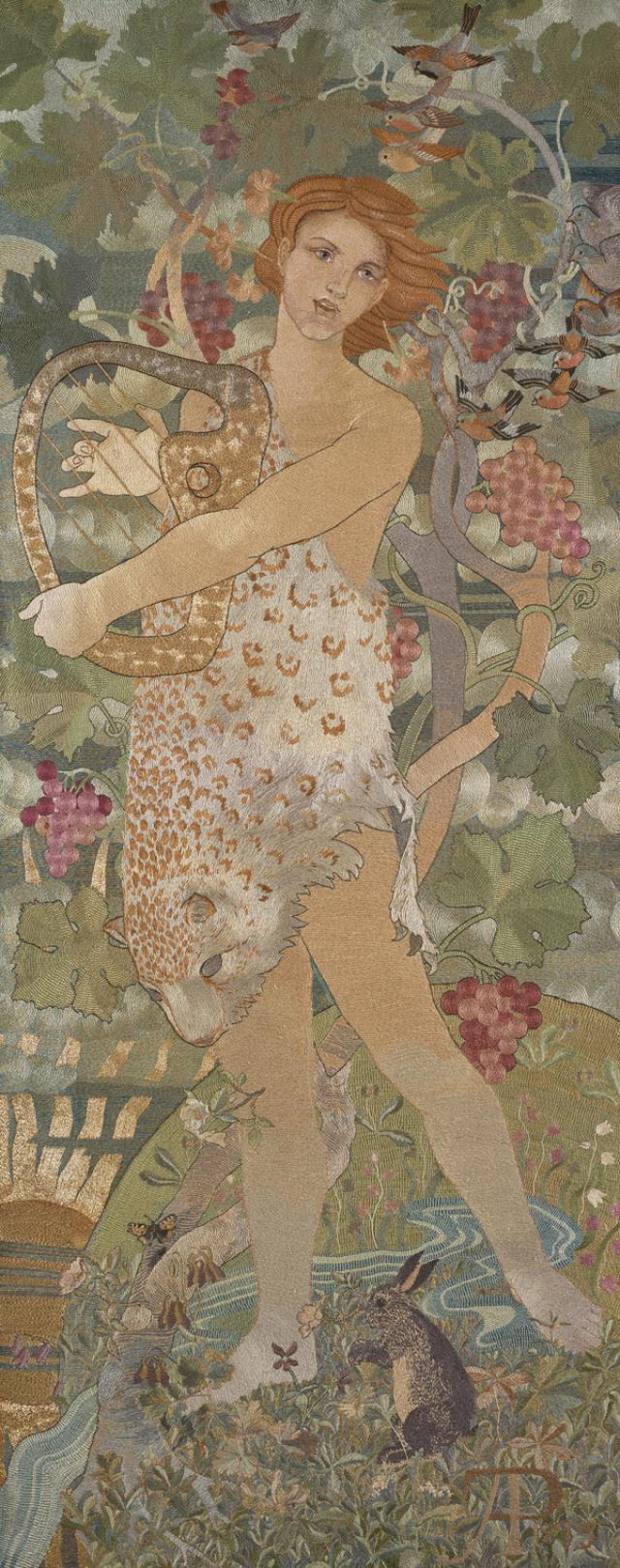
The Progress of a Soul: The Entrance • 1895
Phoebe Anna Traquair (Scottish, Irish-born, 1852-1936) • The Progress of the Soul • Four emroidered tapestry panels • 1897-1902

The Progress of a Soul: The Stress • 1897

The Progress of the Soul: Despair
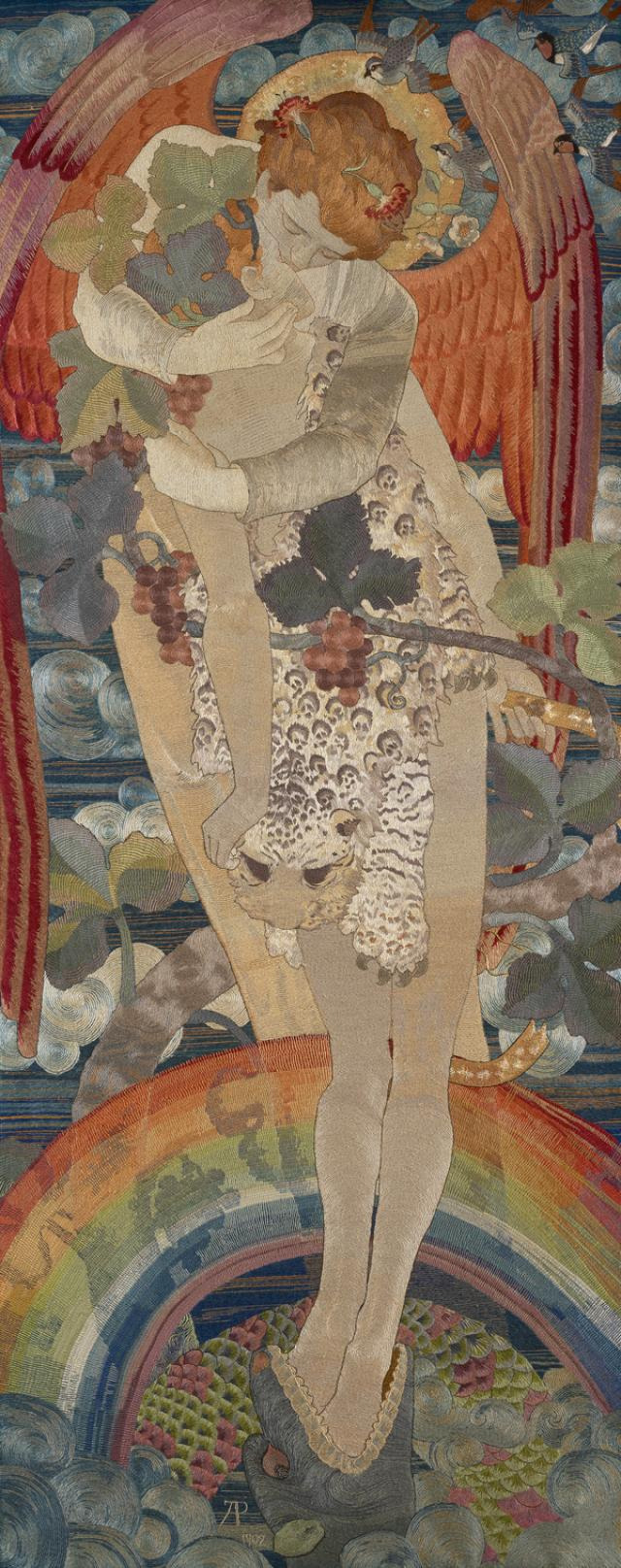
The Progress of the Soul: Victory • 1902
#art#textile art#embroidery as art#thematic series#arts and crafts movement#british artist#spiritual art#figurative art#phoebe traquair#celtic revival#decorative embroidery#embroidered tapestries#woman artist#pre raphaelite
15 notes
·
View notes
Text

Angus Og, God of Love and Courtesy, Putting a Spell of Summer Calm on the Sea. (John Duncan, 1908)
#john duncan#celtic art#scottish art#angus og#symbolism#i got this image from wikipedia cause the national gallery one is insanely crusty. this is why i cant trust the other tumblr uploaders#celtic revival#pre raphaelite
2 notes
·
View notes
Photo
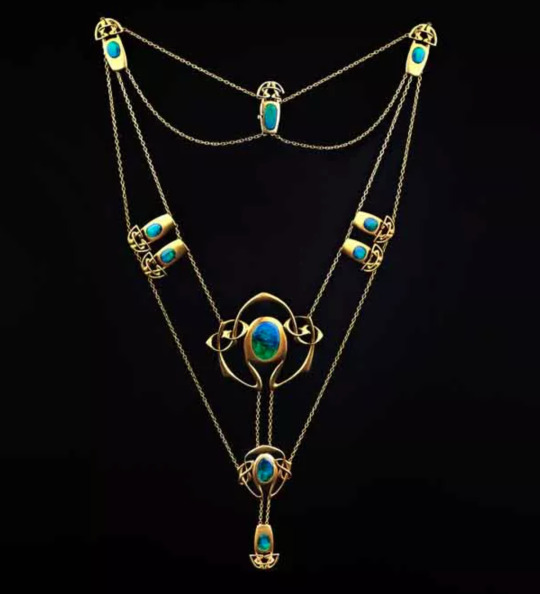
4 notes
·
View notes
Text

Harry Clarke, detail from the Geneva Window.
#Harry Clarke#Stained Glass#Fairy#Seumas O’Sullivan#Celtic Revival#Fin-de-Siècle#Arts and Crafts#Faerie
5 notes
·
View notes
Text
A blogpost I wrote last year on such an underrated Irish writer!
#katharine tynan#ballads and lyrics#irish folklore#folklore#women's writing#sadbh kellett#celtic revival#fairies#sídhe#fairy#irish revival#ireland#irish writer#phd#university of st andrews#Irish Women's Writing Network#Academia
14 notes
·
View notes
Text
#OTD in 1865 – Birth of writer and nationalist, W.B. Yeats, in Dublin.
#OTD in 1865 – Birth of writer and nationalist, W.B. Yeats, in Dublin.
William Butler Yeats was the son of painter John Butler Yeats. He spent much of his childhood in Co Sligo which was a huge source of inspiration for him, not least the beautiful ‘Lake Isle of Inisfree’.
Yeats was a major player in the Celtic Revival which endeavored (successfully) to raise awareness of the culture of Ireland, much of which had been decimated by English rule. His personal and…

View On WordPress
#Celtic Revival#Co. Sligo#Drumcliffe#Dublin#Irish History#Irish Literary Theatre#John Butler Yeats#Maud Gonne#Nobel Prize for Literature#Sandymount#William Butler Yeats
9 notes
·
View notes
Text

Angel in the city: The Awakening
Phoebe Anna Traquair
National Galleries of Scotland
Edinburgh
#found#art#modern art#angels of edinburgh#angel#angels in art#angels#Phoebe Anna Traquiar#symbolism#Celtic revival#scottish artist#scotland#Scottish art#women’s art#women in art#20th century
1 note
·
View note
Text
Oh you're a "Celtic Pagan"? Please provide your thoughts on our collective performances in the Euro qualifiers so far. You know, because you were obviously watching the games, right?
0 notes
Text
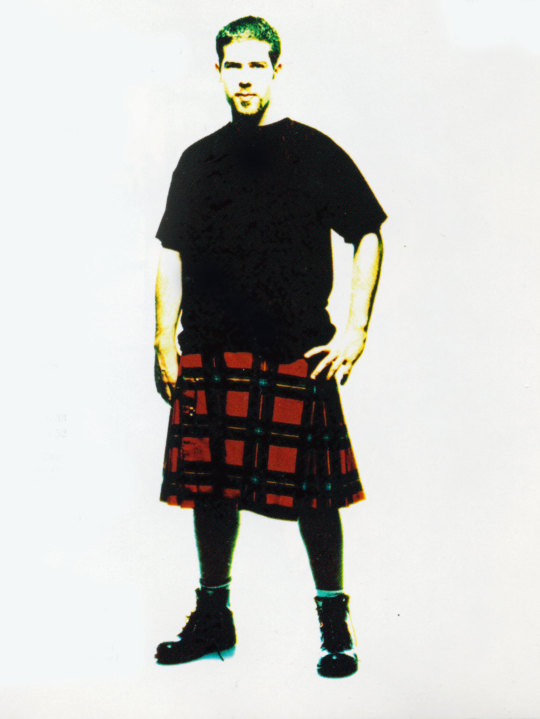
Canadian Fiddler Ashley MacIsaac
Photo Credit: Derek Shapton
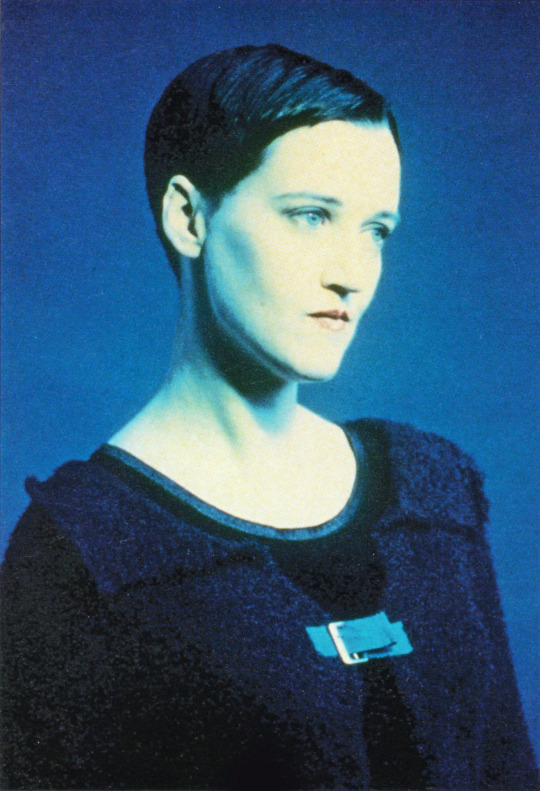
Canadian Gaelic singer Mary Jane Lamond
Photo Credit: Derek Shapton
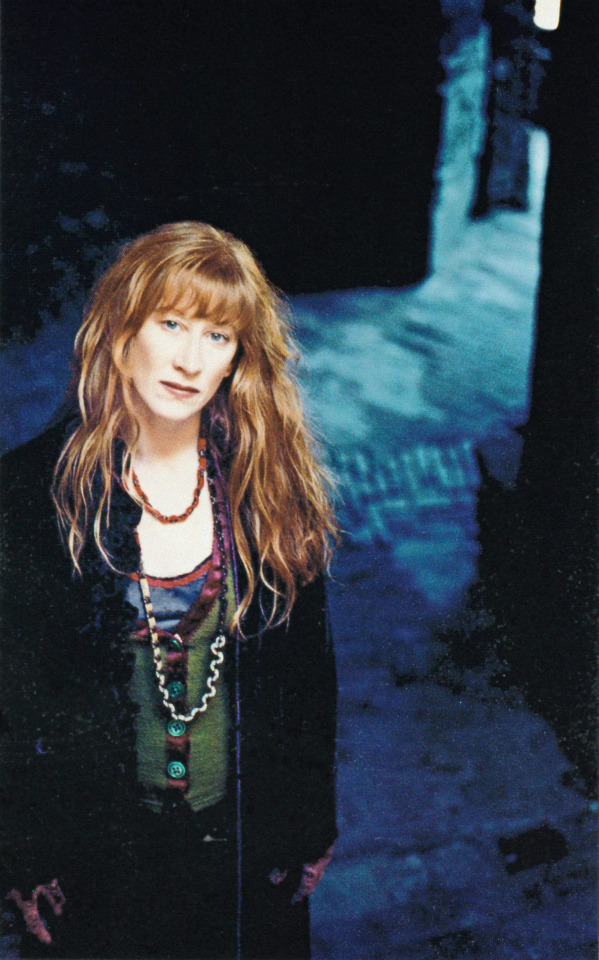
Canadian singer-songwriter Loreena McKennitt
1990's Celtic music revival:
Celtic music is a type of music my mother did not mind me listening to and I became very interested in it in the 90s. There was a Celtic rock revival going on in Canada, and many Celtic artists had songs playing on mainstream radio such as "Sleppy Maggie" (Ashley MacIsaac and Mary Jane Lamond), "The Mummer's Dance" (Loreena McKennitt), "Ordinary Day" (Great Big Sea), etc.
#Mary Jane Lamond#Ashley MacIsaac#Celtic#celtic music#celtic rock#folk music#scottish gaelic#Irish#cape breton#canada#nova scotia#90s music#90s#celtic revival#loreena mckennitt
1 note
·
View note
Text
Speakers of non-English languages of the UK and Ireland wanted!!
Since it’s World Mother Language Day today (February the 21st), I’m thinking of doing a series of posts on the native non-English languages of the United Kingdom and Ireland, with some information and short interviews.
For this, I am looking for both native speakers/signers and learners (with or without parentage/heritage of the language in question) of the following languages:
- Scottish Gaelic
- Irish
- Welsh
- Any sign language of the United Kingdom or Ireland (e.g. BSL)
- Any other minority language indigenous to the United Kingdom or Ireland. By this I mean primarily spoken only within the UK or Ireland as a minority, or spoken very little elsewhere. For example: Cornish, Manx, Shelta, or Anglo-Romani, not languages like Polish or Bengali that are minority within the UK but have a significant speaker base elsewhere. (I am aware that I am fishing for some of these *cough* Cornish *cough*...but you never know!)
- Any language or variety that you speak that you feel is linguistically / culturally distinct from Standard English that you would like to inform more people about. For example: Shetlandic, Scots, Ulster Scots.
I don’t have anything finalised yet, but if you would be wiling to speak to me about some text-based interviews for the sake of qualitative and informative tumblr posts, please send me a message!
(NB: if I have used any names of languages that are not preferred, tell me and I will change them. I don’t know a lot about the non-Celtic and non-Germanic languages here, which is part of my reason for wanting to make this series of posts in the first place.)
Please reblog so more people see this!
- meichenxi
#irish#welsh#scottish gaelic#gaelic#bsl#world mother language day#please reblog <3#every single time I tell anyone (brits included) about the variety of languages that exist natively in the UK and Ireland I die a little#<< that is a joke and I enjoy informing others but also. there's more than english please#cornish and breton and manx....look. if ANYONE on the internet is learning those languages as a second language learner#they are on Tumblr. this I know to be true#*manifesting*#cornish is on my list of celtic languages to learn in the future. but first gaelic. and then welsh since my family is moving there#and THEN perhaps cornish. *meme voice* I just think it's neat!#I also like the challenge of being at the forefront of a revival moment that is almost entirely made up of nerds (affectionate)
455 notes
·
View notes
Text
UNBLENDING CELTIC POLYTHEISTIC PRACTICES
Celtic Umbrella
This lesson is largely focusing on the insular Celtic nations & Brittany (Ireland/Eire, Scotland/Alba, Wales/Cymru, Cornwall/Kernow, Isle of Man/Mannin, & Brittany/Breizh) - traditionally regarded as 6 out of the 7 Celtic nations. Galicia/Galizia is the 7th, but because of a mix of the below + my own lack of knowledge, I won't be covering them.
The vast swath of Continental Celtic cultures are a different but equally complex topic thanks to extinction, revival, varying archaeological artefacts and the work of modern practioners to piece unknown parts back together.
This will serve as a quick 'n' dirty guide to the insular Celtic nations, Celtic as a label, blood percentages and ancestry, the whats and whys of "Celtic soup", and how to unblend practice.
The insular Celtic groups are split into two language groups: Brythonic languages and Gaelic languages.
Brythonic languages are Cymraeg/Welsh, Kernewek/Cornish, & Breton
Gaelic languages are Gàidhlig/Scottish, Gaeilge/Irish, & Gaelg/Manx.
The language split leads to certain folkloric and religious figures & elements being more common within the language group than without. All of these nations had historic cultural exchange and trade routes via the Celtic sea (and beyond). Despite this, it is still important to respect each as a home to distinct mythologies.
Pros/Cons of a broad Celtic umbrella
Pros
- Used within celtic nations to build solidarity
- Relates to a set of cultures that have historic cultural exchange & broad shared experiences
- A historic group category
- Celtic nations’ culture is often protected under broad legislation that explicitly highlights its ‘Celtic-ness’.
Cons
- Can be used reductively (in academia & layman uses)
- Often gives in to the dual threat of romanticisation/fetishisation & erasure
- Conflates a lot of disparate practices under one banner
- Can lead to centring ‘celtic american’ experiences.
- Celtic as a broad ancestral category (along with associated symbols) has also been co-opted by white supremacist organisations.
In this I’m using ‘Celtic’ as a broad umbrella for the multiple pantheons! This isn’t ideal for specifics, but it is the fastest way to refer to the various pantheons of deities that’ll be referenced within this Q&A (& something that I use as a self identifier alongside Cornish).
What about blood % or ancestry?
A blood percentage or claimed Celtic ancestry is NOT a requirement to be a follower of any of the Celtic pantheons. The assumption that it does or is needed to disclose can feed easily into white supremacist narratives and rhetoric, along side the insidious implications that a white person in the USA with (perceived or real) Celtic ancestry is 'more celtic' than a person of colour living in a Celtic region (along with other romanticised notions of homogenously white cultures).
Along side this, a blood percentage or distant ancestry does not impart the culture and values of the Celtic region or it's recorded pagan practices by itself. Folk traditions are often passed down within families, but blood percentage is not a primary factor within this.
Connecting with ancestry is fine, good, and can be a fulfilling experience. It stops being beneficial when it leads to speaking over people with lived experiences & centres the USA-based published and authors - which can lead to blending/souping for reasons further on.
What is 'soup'?
Celtic soup is a semi-playful term coined by several polytheists (primarily aigeannagusacair on wordpress) to describe the phenomenon of conflating & combining all the separate pantheons and practices from the (mainly) insular Celtic nations into one singular practice - removing a lot of the regionalised folklore, associated mythos, & varying nuances of the nations that make up the soup.
Why does it happen?
The quick version of this is book trends and publishing meeting romanticisation and exotification of Celtic cultures (especially when mixed with pre-lapsarian views of the Nations). It's miles easier to sell a very generally titled book with a lot of Ireland and a little of everywhere else than it is to write, source and publish a separate book on each.
This is where centering American publishers and authors becomes an issue - the popular trend of USA-based pagan publications to conflate all celtic nations makes it hard to find information on, for example, Mannin practices because of the USA’s tendency to dominate media. Think of Llewellyn’s “Celtic Wisdom” series of books.
It has also been furthered by 'quick research guides'/TL;DR style posts based on the above (which have gained particular momentum on tumblr).
The things that have hindered the process in unblending/"de souping" is the difficulty in preserving independently published pamphlets/books from various nations (often more regionalised and immediately local than large, sweeping books generalising multiple practices) along with the difficulty of accessing historic resources via academic gatekeeping.
All of this has lead to a lack of awareness of the fact there is no, one, singular Celtic religion, practice or pantheon.
Why should I de-soup or unblend my practice?
Respecting the deities
It is, by and large, considered the bare minimum to understand and research a deity's origin and roots. The conflation of all insular Celtic deities under one singular unified pantheon can divorce them from their original cultures and contexts - the direct opposite to understanding and researching.
Folklore and myth surrounding various Celtic deities can be highly regionalised both in grounded reality and geomythically - these aren't interchangeable locations and are often highly symbolic within each nation.
Brú na Bóinne, an ancient burial mound in Ireland, as an entrance to the otherworld of the Tuatha Dé Danann.
Carn Kenidjack & the Gump as a central site of Cornish folk entities feasts and parties, including Christianised elements of Bucca’s mythology.
The Mabinogion includes specific locations in Wales as well as broad Kingdoms - it’s implied that Annwn is somewhere within the historic kingdom of Dyfed, & two otherworldly feasts take place in Harlech & Ynys Gwales.
Conflating all celtic pantheons under one banner often leads to the prioritisation of the Irish pantheon, meaning all of the less ‘popular’ or recorded deities are sidelined and often left unresearched (which can lead to sources & resources falling into obscurity and becoming difficult to access).
Respecting the deities
Deities, spirits, entities, myth & folklore are often culturally significant both historically and to modern day people (just average folks along with practitoners/pagans/polytheists and organisations) located in the various Nations
A primary example is the initiatory Bardic orders of Wales and Cornwall.
Desouping/Unblending makes folklorist's lives easier as well as casual research less difficult to parse. The general books are a helpful jumping off point but when they constitute the bulk of writing on various Celtic polytheisms, they become a hinderance and a harm in the research process.
A lot of mythology outside of deities & polytheisms is also a victim of ‘souping' and is equally as culturally significant - Arthurian mythology is a feature of both Welsh and Cornish culture but is often applied liberally as an English mythology & and English figure.
Celtic nations being blended into one homogenous group is an easy way to erase cultural differences and remove agency from the people living in celtic nations. Cornwall is already considered by a large majority of people to be just an English county, and many areas of Wales are being renamed in English for the ease of English tourists.
How can I de-soup?
Chase down your sources' sources, and look for even more sources
Check your sources critically. Do they conflate all pantheons as one? Do they apply a collective label (the celts/celts/celt/celtic people) to modern day Celtic nations? How far back in history do they claim to reach?
Research the author, are they dubious in more ways than one? Have they written blog articles you can access to understand more of their viewpoints? Where are they located?
Find the people the author cites within their work - it can be time consuming but incredibly rewarding and can also give a good hint at the author's biases and research depth. You may even find useful further reading!
Find primary sources (or as close too), or translations of the originating folklore, e.g The Mabinogion. Going to the source of a pantheon’s mythos and folklore can be helpful in discerning where soup begins in more recent books as well as gaining insight into deities' actions and relationships.
Ask lots of questions
Question every source! Question every person telling you things that don't define what pantheon or region they’re talking about! Write all your questions down and search for answers! Talk to other polytheists that follow specific Celtic pantheons, find where your practices naturally overlap and where they have been forced into one practice by authors!
Be honest with yourself
There’s no foul in spreading your worship over several pantheons that fall under the celtic umbrella! A lot of polytheists worship multiple pantheons! But be aware of the potential for soup, and make sure you’re not exclusively reading and working from/with sources that conflate all practices as one.
If you approach any Celtic polytheistic path with the attitude of blood percentage or 'ancestral right', stop and think critically about why you want to follow a Celtic polytheistic path. Is it because it's the most obviously 'open' path to follow? Is it a desire to experience what other folks experience? Being critical, turning inward, and really looking at yourself is important.
Originally posted in the Raven's Keep discord server
#celtic polytheism#celtic paganism#celtic soup#celtic#celtic reconstructionism#celtic revivalism#celtic polytheist#celtic pagan#celtic religion
433 notes
·
View notes
Link
A series of short films has been produced in Cornish (with English subtitles).
I know Tumblr loves a Celtic language, so please show these some love, and then maybe more media will get produced yn Kernowek.
#cornish#cornwall#kernowek#kernow#cornish langblr#minority language#celtic language#brythonic language#revived language
212 notes
·
View notes
Text
Ancient Paganism on the Islands of early Modern Ireland

The islands of Inishkea (Inis Cé) also known as Inis Geidhe or Inish Gay are a pair of islands off the coast of Belmullet, County Mayo. One of the most remote parts of Ireland. These areas have a lot of history. With habitation evident in both Neolithic and early Christian eras. The island is said, in the Irish Version of the Historia Britonum to have been occupied by a single Crane since the beginning of the world, and is named after an obscure female saint from around circa 800 AD.
The evidence for pagan or pagan like practice's in Inishkea comes from a series of accounts.
Protestant Robert Jocelyn in 1851 described the practices of the island in his book “Progress of the Reformation in Ireland – Extracts from a series of letters written from the West of Ireland to a friend in England, in September 1851” as:
“..save during the few and necessarily short visits of the clergyman of the parish, seldom have they heard of eternal life as the free gift of God through Jesus Christ, and even these visits were unprofitable from their total ignorance of English... their worship consists in occasional meetings at their chief’s house, with visits to a holy well, called in their native tongue, Derivla... Here the absence of religion is filled with the open practice of Pagan idolatry... In the South Island, in the house of a man named Monigan, a stone idol, called in the Irish ‘Neevougi’ has been from time immemorial religiously preserved and worshipped. This god in appearance resembles a thick roll of home-spun flannel, which arises from the custom of dedicating a dress of that material to it, whenever its aid is sought; this is sewed on by an old woman, its priestess, whose peculiar care it is”
Caesar Otway in his 1841 book “Sketches in Erris and Tyrawly” describes the practice's as:
“… they have what is better called by some the Neevoge or as others pronounce it Knaveen; both mean the ‘little saint’, and I prefer the latter pronunciation which may not be a bad derivation for the English word knave, Latin gnavus, a knowing fellow. For the Knaveen of Inniskea must be a knowing one indeed, for by his instrumentality, the natives consider they can raise or allay a tempest, raise a storm when a ship nears the island, and so they may get in a wreck or allay it when their own boats are out at sea in a gale of wind. The Knaveen is a stone image of the rudest construction, attired in an undyed flannel dress which is every New Year’s Day renewed”
Caesar later describes how a pirate smashed the idol, but local people found the pieces and wrapped them together in cloth.
Description:
Both accounts describe a Naomhóg, a stone idol wrapped in flannel. The stone is said to have been small, weighing 2-3 pounds, been greenish and the size and shape of a smoothing iron (the precursor to the modern iron)
Abilities:
The idols power is said to have been able to bring abundance in the form of wrecked ship landings and growing potatoes, heal the sick. protect from weather, quell fire, raise winds.
Worship:
The people of the island were said to wrap the idol in a flannel, varying in colour but usually depicted as red, which was replaced each year. It was sewn by an older woman, described as a priestess. The people of the island were said to kiss the idol in thanks. The idol usual resided in the wall of the house of the chief. The idol was brought along of certain journeys for protection, The people were also to have worshipped at a holy well nearby though the relation to the idol is unsaid.
Fate of the idol:
The Naomhóg was broken by pirates but ultimately pieced and bound together. The idol supposedly was thrown into Portavally harbour by a catholic priest to get rid of it.
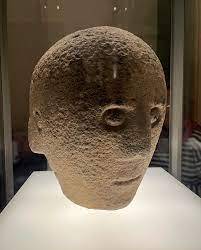
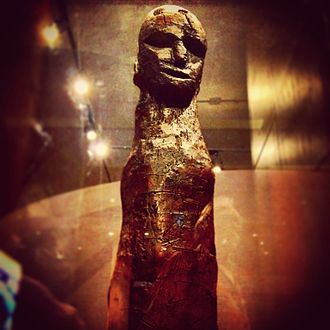
Pagan?
Idols such as Ralaghan Man, the Boa island statue and Corleck Head are pre-Christian objects thought to be used for ritual purposes. This along with the distinctly pagan powers over earth, sea and sky, and its dedicated worship suggest a pre catholic origin. Worth noting is the word “naomh” meaning saint is one of the few Irish word relating to religion to not come from Latin and instead from proto-celtic. The figure, which is described as feminine could possibly related to a pre christian St. Geidh represented by a Crane.
Christian?
The idea of pagans on Inishkea is not without fault though. The island was home to a church dedicated to St. Colmcille, with evidence of monastery life from 540 AD. This is at odds with the supposed ancient paganism. Later accounts also suggest that the people of the island believed that the idol was from said church. There were also efforts to claim that the idol was anything Christian related from a cross to a broken piece of a jesus statue.
Possibilities:
Misinterpretation:
It is hardly a secret that protestants from the UK heavily looked down upon the catholic practices of Ireland and this may have been viewed as heathenry. Post famine catholic church also made an effort to ensure practices lined up with Rome, making them view the practices as unfavourable.
They Forgot:
The islands remote position may have made it so that when the catholic centre collapsed, the people were left isolated and thus had to practise their religion from what they knew, which eventually evolved into the worship of an item associated with a saint.
A Snapshot In Time:
The idol may very well be from a time when newer catholic traditions were introduced, as we know that the church is from an era where pagans were still common, and as such merged local practices, the concept of a female guardian of winds being brought into a christian perceptive as a saint . Life in the monastery may very well have involved pagan elements that were never corrected due to the rural location, this merged christian/pagan practice may very well have contiuned onto the modern(ish) day, with increasing yet brief christainisation from interlopers. This is personally what I think is most likely.
Further info.
#Irish paganism#gaelic paganism#celtic paganism#Irish Reconstructionism#irish revivalism#paganism#irish polytheism#gaelic polytheism#celtic polytheism#modern paganism#Irish#Mayo#Ireland#inishkea#witchblr#witch#witchy#irish mythology#mine#dia#na déithe
81 notes
·
View notes
Text

Kernow or, in English, Cornwall
One of the most forgotten Celtic nations, and often not thought of more than one of the counties of England: Cornwall used to have its own Celtic language, Cornish, before the last native speaker died at the end of the 18th century. However since then, its language has been revived.
Cornish and Manx are two of the few languages in Europe to be successfully revived, with new native speakers as of this century.
3 notes
·
View notes
Text
Revival of the Irish Wolfhound
The Irish wolfhound is a persistent symbol of ancient Celtic nobility and integrity. By the middle of the 19th century the original Irish wolfhound had all but disappeared, along with its foe the Irish wolf, and no one really had a clear idea of what it had looked like in its heyday.
Around this time, however, it became the beneficiary of an obsession on the part of an Englishman named Captain…
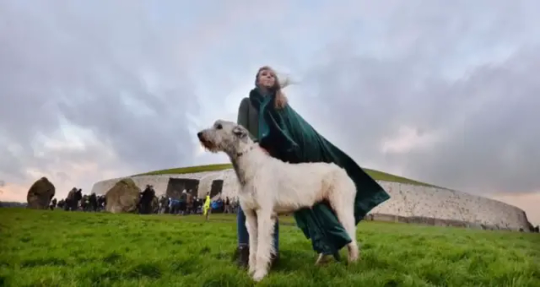
View On WordPress
#Captain George Augustus Graham#Celtic nobility#Dogs of Ireland#Ireland#Irish Wolf#Irish Wolfhound#Revival of Irish Wolfhound
20 notes
·
View notes
Text


*Screams in Celtic academia*
#There's so much to unpack but the refusal to acknowledge you are *inventing* a spirituality and not reviving one is the main point#“The faeries are waiting” well then freaking RUN darling#Supernatural beliefs are NOT spirituality#Stop erasing the deeply Christian history of celtic cultures#Celtic spirituality means everything and NOTHING#Druids???#Oh yes so you've made a coherent whole of 3000 years of history my bad#Celtic#Wales#This truly reminds me of white Buddhism
4 notes
·
View notes